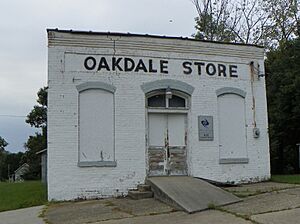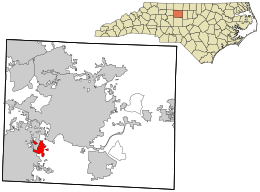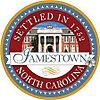Jamestown, North Carolina facts for kids
Quick facts for kids
Jamestown, North Carolina
|
|||
|---|---|---|---|

Oakdale Cotton Mill Village
|
|||
|
|||
| Motto(s):
"Walking with History"
|
|||

Location in Guilford County and the state of North Carolina
|
|||
| Country | United States | ||
| State | North Carolina | ||
| County | Guilford | ||
| Founded | 1752 | ||
| Incorporated | 1816, 1947 | ||
| Named for | James Mendenhall | ||
| Area | |||
| • Total | 3.00 sq mi (7.76 km2) | ||
| • Land | 3.00 sq mi (7.76 km2) | ||
| • Water | 0.00 sq mi (0.00 km2) | ||
| Elevation | 820 ft (250 m) | ||
| Population
(2020)
|
|||
| • Total | 3,668 | ||
| • Density | 1,223.89/sq mi (472.56/km2) | ||
| Time zone | UTC-5 (Eastern (EST)) | ||
| • Summer (DST) | UTC-4 (EDT) | ||
| ZIP code |
27282
|
||
| Area code(s) | 336 | ||
| FIPS code | 37-34300 | ||
| GNIS feature ID | 2405904 | ||
Jamestown is a town located in Guilford County, North Carolina, United States. It is a town close to the larger cities of Greensboro and High Point. In 2020, about 3,668 people lived in Jamestown.
Contents
Exploring Jamestown's Location
Jamestown is found in the central part of North Carolina. The city of High Point is right next to Jamestown on its western side. Downtown Greensboro is about 11 miles (18 km) to the northeast.
Getting Around Jamestown
Interstate 74 goes around Jamestown. This highway helps people travel to other cities like Winston-Salem and Asheboro. Other main roads like Lexington Road and Main Street connect Jamestown to Greensboro and High Point. The Jamestown Parkway also helps people travel between Greensboro and High Point.
Jamestown covers about 3 square miles (7.8 square kilometers) of land. The Deep River flows through the southern part of the town. This river eventually joins the Cape Fear River.
People of Jamestown
As of 2020, there were 3,668 people living in Jamestown. These people made up 1,812 households. Most residents were White (72.66%), followed by Black or African American (14.86%). Other groups included Asian, Native American, and people of mixed races. About 4.36% of the population was Hispanic or Latino.
Jamestown's Rich History
Early Native American Life
Around 1701, the Keyauwee people lived in this area. They were an Native American tribe who enjoyed the mild weather and rich natural resources. The Deep and Uwharrie rivers provided good hunting grounds.
The Keyauwee were part of a group of many tribes. By the 1760s, they likely moved south. They probably joined the Catawba tribe near the border of North and South Carolina.
Quaker Settlers Arrive
In the late 1700s, European families began to settle in Jamestown. Many of these families were Quakers. They moved from Pennsylvania looking for good farmland. James Mendenhall was one of the first settlers. He started a farm near where Jamestown is today in 1752.
James Mendenhall moved away in 1775, but his son George stayed. In 1816, George founded the village of Jamestown. He named it to honor his father. The Mendenhall family owned the first mills in the area. They also owned much of the original land in the town. Today, High Point City Lake is where their family farm used to be.
During the Revolutionary War in 1781, British General Cornwallis' army camped near Jamestown. They took supplies from local farms and mills. This happened before a big battle with General Nathanael Greene's troops.
Jamestown in the 1800s
By 1800, Jamestown was a busy place with 150 residents. It had its own post office, an inn, and a Freemasons' lodge. Around this time, gold was found near Jamestown. Several mines operated there. However, the California Gold Rush later caused these local mines to close.
In 1811, Richard Mendenhall, James's son, built the Mendenhall Plantation homestead. Richard was a local tanner. Today, this homestead is a popular place to visit in Jamestown.
Jamestown was also known for its gun factory. This factory made a strong and accurate muzzle-loading gun called the "Jamestown Rifle." This gun was very important to Jamestown's economy in the late 1800s. Today, these rifles are valuable collector's items.
During the Civil War, Jamestown's Quakers tried to stay neutral. They were against war and violence. However, the Confederacy made people who could make shoes, uniforms, or weapons continue to do so. If they refused, they had to pay high taxes. Records show that Confederate President Jefferson Davis passed through Jamestown after the Civil War ended.
Before the war, Jamestown was a stop on the Underground Railroad. This was a secret network that helped enslaved people escape to freedom in the North. Many Quaker homes in the area had secret trap doors to help people hide. The Mendenhall and Beard families were very important in helping with these efforts.
In 1856, a railroad was built through Jamestown. It still helps transport goods and some passengers today.
Jamestown in the 1900s
In April 1947, the North Carolina General Assembly officially made Jamestown a town. Soon after, Jamestown started planning its growth. It began building a water and sewer system.
T. C. Ragsdale Sr. was the town's first mayor. Charles P. Turner was the first town manager.
By the 1950s, Jamestown had about 750 people. It had street lights, water and sewer services, and a fire department.
Jamestown grew quickly in the 1960s. New neighborhoods were built on old farmland. The town also built a liquor store, which helped pay for new water and sewer lines. These funds also helped build Town Hall in 1967 and the Jamestown Park and Golf Course in 1974.
Several historic places in Jamestown are listed on the National Register of Historic Places. These include the Former Jamestown High School, Gardner House, Jamestown Historic District, McCulloch's Gold Mill, Richard Mendenhall Plantation Buildings, Oakdale Cotton Mill Village, and Ragsdale Farm.
Education in Jamestown
In 1907, North Carolina passed a law to create public high schools. Jamestown Public School was built and became one of the best schools in Guilford County. It even had dorms for students who lived far away. In 1914, a fire destroyed the school, but a new one was built the next year. This building is now the Jamestown Public Library.
The school continued to grow. A new high school opened in Jamestown in September 1959. It was named Ragsdale High School to honor Lucy Coffin Ragsdale. She cared a lot about public education in Jamestown. Ragsdale High School is one of 26 high schools in the Guilford County Schools system.
Millis Road Elementary School opened in 1961. It helped reduce crowding in the Jamestown school district. It started with 360 students and 12 teachers. Today, it serves about 515 students from pre-kindergarten to fifth grade.
To handle the town's growth, Jamestown has built two more elementary schools and one more middle school. Adults in Jamestown can also attend Guilford Technical Community College for higher education.
Notable People from Jamestown
Many interesting people have connections to Jamestown:
- Mark Dixon – A former professional football player in the NFL.
- Mary Mendenhall Hobbs – She worked hard to support women's education and rights.
- Pat McCrory – He served as the 74th Governor of North Carolina.
- Siri Mullinix – A goalkeeper for the U.S. women's Olympic soccer team in 2000.
- Paul Martin Newby – A justice on the North Carolina Supreme Court.
- Larry Ogunjobi – A professional football player, a defensive tackle in the NFL.
- Kasey Redfern – A former professional football punter in the NFL.
- Clyde Simms – A former professional soccer player in MLS.
- Pep Young – A former professional baseball player in MLB.
Jamestown's Climate
Jamestown has a warm and humid climate. It gets rain fairly evenly throughout the year. This type of weather is called a Humid subtropical climate.
| Climate data for Jamestown, North Carolina | |||||||||||||
|---|---|---|---|---|---|---|---|---|---|---|---|---|---|
| Month | Jan | Feb | Mar | Apr | May | Jun | Jul | Aug | Sep | Oct | Nov | Dec | Year |
| Mean daily maximum °C (°F) | 8 (46) |
10 (50) |
15 (59) |
21 (69) |
25 (77) |
29 (84) |
30 (86) |
29 (84) |
26 (78) |
21 (69) |
15 (59) |
10 (50) |
19 (66) |
| Mean daily minimum °C (°F) | −2 (28) |
0 (32) |
2 (35) |
7 (44) |
12 (53) |
17 (62) |
19 (66) |
19 (66) |
15 (59) |
8 (46) |
3 (37) |
0 (32) |
8 (46) |
| Average precipitation mm (inches) | 86 (3.4) |
84 (3.3) |
97 (3.8) |
84 (3.3) |
91 (3.6) |
97 (3.8) |
110 (4.4) |
110 (4.2) |
91 (3.6) |
84 (3.3) |
71 (2.8) |
81 (3.2) |
1,080 (42.6) |
| Source: Weatherbase | |||||||||||||
See also
 In Spanish: Jamestown (Carolina del Norte) para niños
In Spanish: Jamestown (Carolina del Norte) para niños



